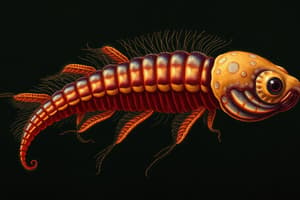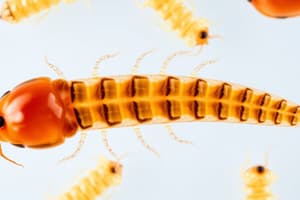Podcast
Questions and Answers
What is the primary difference between cysticercosis and taeniasis in terms of transmission?
What is the primary difference between cysticercosis and taeniasis in terms of transmission?
- Cysticercosis is caused by ingesting adult tapeworms.
- Cysticercosis results from ingesting T.solium eggs. (correct)
- Taeniasis is contracted from undercooked pork.
- Taeniasis occurs when individuals consume infective eggs.
Which tissue is most commonly affected by dormant cysts in cysticercosis?
Which tissue is most commonly affected by dormant cysts in cysticercosis?
- Lungs
- Brain (correct)
- Liver
- Muscles
Which of the following is the usual intermediate host for Taenia solium?
Which of the following is the usual intermediate host for Taenia solium?
- Sheep
- Cows
- Humans
- Pigs (correct)
How can humans inadvertently become intermediate hosts for T.solium?
How can humans inadvertently become intermediate hosts for T.solium?
What are flatworms, which include Taenia solium, classified as?
What are flatworms, which include Taenia solium, classified as?
What characterizes the life cycle of Taenia solium?
What characterizes the life cycle of Taenia solium?
What potential neurological impact can cysticercosis have?
What potential neurological impact can cysticercosis have?
How does taeniasis primarily occur?
How does taeniasis primarily occur?
What are the two different infections caused by Taenia solium depending on the lifecycle stage ingested?
What are the two different infections caused by Taenia solium depending on the lifecycle stage ingested?
Which of the following diseases is associated with a higher Global Burden of Disease (DALYs) than Echinococcosis?
Which of the following diseases is associated with a higher Global Burden of Disease (DALYs) than Echinococcosis?
What characteristic is common to all cestodes?
What characteristic is common to all cestodes?
Which organism is typically an intermediate host for Taenia solium?
Which organism is typically an intermediate host for Taenia solium?
How are nutrients absorbed in cestodes?
How are nutrients absorbed in cestodes?
Which disease listed has the lowest total burden of disease according to the data provided?
Which disease listed has the lowest total burden of disease according to the data provided?
What type of worms are cestodes classified as?
What type of worms are cestodes classified as?
Which of the following diseases is NOT caused by a cestode?
Which of the following diseases is NOT caused by a cestode?
What is a primary symptom associated with neurocysticercosis?
What is a primary symptom associated with neurocysticercosis?
Which of the following statements accurately describes cysticercosis?
Which of the following statements accurately describes cysticercosis?
What distinguishes taeniasis from cysticercosis?
What distinguishes taeniasis from cysticercosis?
Which organism is primarily responsible for causing cysticercosis?
Which organism is primarily responsible for causing cysticercosis?
What is considered a potential intermediate host for Taenia solium?
What is considered a potential intermediate host for Taenia solium?
In the lifecycle of Taenia solium, what develops in the intermediate host?
In the lifecycle of Taenia solium, what develops in the intermediate host?
Which of the following is a common manifestation of disseminated cysticercosis?
Which of the following is a common manifestation of disseminated cysticercosis?
Which statement best describes the pathogenesis of cestodes like Taenia solium?
Which statement best describes the pathogenesis of cestodes like Taenia solium?
Flashcards
Cysticercosis
Cysticercosis
Infection caused by the larval stage of the pork tapeworm (Taenia solium).
Neurocysticercosis
Neurocysticercosis
Cysticercosis affecting the brain, potentially causing severe symptoms like seizures and headaches.
Taeniasis
Taeniasis
Infection by the adult tapeworm (Taenia solium) in the intestines.
Platyhelminths
Platyhelminths
Signup and view all the flashcards
Cestodes
Cestodes
Signup and view all the flashcards
Seizures
Seizures
Signup and view all the flashcards
Hydrocephalus
Hydrocephalus
Signup and view all the flashcards
Asymptomatic
Asymptomatic
Signup and view all the flashcards
Taenia solium
Taenia solium
Signup and view all the flashcards
Intermediate host
Intermediate host
Signup and view all the flashcards
Infective eggs
Infective eggs
Signup and view all the flashcards
T. solium eggs
T. solium eggs
Signup and view all the flashcards
Pork tapeworm
Pork tapeworm
Signup and view all the flashcards
Human tapeworm carrier
Human tapeworm carrier
Signup and view all the flashcards
Hermaphroditic
Hermaphroditic
Signup and view all the flashcards
Global Burden of Cestode Infections (DALYs)
Global Burden of Cestode Infections (DALYs)
Signup and view all the flashcards
Helminths
Helminths
Signup and view all the flashcards
Mass Drug Administration
Mass Drug Administration
Signup and view all the flashcards
Study Notes
TM29 Helminths 3 Trematodes & Cestodes
- Topics covered: Trematodes, Cestodes, Schistosomiasis, Taenia, Echinococcus, Cysticercosis, and Echinococcosis
Helminths 3: Learning Outcomes
- Schistosomiasis: Epidemiology, life-cycle, clinical presentation, management, diagnosis, prevention, and natural history
- Taenia and Echinococcus: Life-cycle, diagnosis, treatment, and prevention
Trematodes (Flukes)
- Flat & tongue-like
- Oral & ventral suckers
- Incomplete digestive system (no anus)
- Creeping motion
- Hermaphroditic (except Schistosoma)
- Classes of Flukes: Liver flukes (Fasciola hepatica, Fasciola gigantica, Opisthorchis, Clonorchis, Paragonimus), Lung flukes (Paragonimus), Gut flukes (Fasciolopsis buski), Blood flukes (Schistosoma)
Cestodes (Tapeworms)
- Ribbon-like segmented bodies
- No digestive system; nutrients absorbed through body wall
- Hermaphroditic
- Types of Cestodes: Taenia, Echinococcus
Schistosomiasis
- Epidemiology: Tropics & subtropics, poor communities, poor water/sanitation, primarily affecting children. 90% in Sub-Saharan Africa
- Life Cycle: Snail(intermediate host) → human; penetration of skin, cercariae, liver and egg laying
- Clinical Presentation: Acute: fever, flu-like illness, cough/wheeze/SOB, diarrhoea, eosinophilia, urticaria, dermatitis (at site of penetration). Chronic: fibrosis & granulomatous reaction, stunted growth, impaired cognitive development, anaemia
- Specific Clinical Presentation: Urogenital: Cystitis, haematuria, obstructive uropathy, Chronic Kidney Disease (CKD), Infertility, Bladder Cancer. Hepatic/Intestinal: Bloody diarrhoea, intestinal polyps, hepatomegaly, cirrhosis/chronic liver disease, portal hypertension, splenomegaly, varices.
- Diagnosis: Clinical presentation, eosinophilia suggests, urine/stool microscopy (peak shedding at midday), antigen tests (active infection).
- Management: Praziquantel x2 doses (60-90% cure rate, safe in pregnancy, cheap). Wait 12 weeks after suspected infection to allow juvenile worms to develop into adults.
- Prevention & Control: WaSH (Water, Sanitation, and Hygiene) education, safe clothes-washing, toilet facilities beside lakes, clean water, clear snail breeding habitats, using chemicals to kill snails, biological killing of snails (fish), Mass Drug Administration (MDA) with Praziquantel
Cysticercosis (Taenia solium)
- The same tapeworm (Taenia solium) causes two different infections depending on the stage of the life cycle ingested.
- Cysticercosis: ingestion of T. solium eggs.
- Taeniasis: ingestion of T. solium adult tapeworm.
- Life Cycle: Pigs= intermediate hosts → Humans ingest infective eggs → dormant cysts form in any tissue (most commonly brain, eyes, subcutaneous tissues)
- Clinical Presentation: Brain (Neurocysticercosis): Asymptomatic, headaches, seizures, hydrocephalus. Eyes, Subcutaneous tissues
- Diagnosis: Imaging of brain and other tissues. Faecal microscopy for proglottids
- Management: Active Neurocysticercosis: Cyst destruction → inflammatory response, Praziquantel + Albendazole + Steroids +/- antiepileptic drugs. Inactive Neurocysticercosis: No treatment required.
- Prevention & Control: Health education - hygiene, food safety, Improved sanitation, Test & treat human Taenia carriers, Improved pig husbandry (no free-roaming), Vaccination & treatment of pigs, Improved meat inspection, Cook meat thoroughly
Echinococcosis
- Cystic Echinococcosis (Hydatid Disease): accounts for most global Echinococcosis Cases; 2-4% mortality
- Alveolar Echinococcosis: harder to treat, worse outcomes, high mortality rate
- Life cycle: Ingestion of eggs by sheep → cysts form in sheep tissues → ingestion by dog → adults developed in dog's intestines → eggs shed in dog feces → humans ingest → cysts form in various organs
- Clinical Presentation: Symptoms due to pressure from cysts (Liver(70%)-obstruction → jaundice, RUQ pain, liver failure; Lungs (15-30%)– dyspnoea, cough, chest pain). May be asymptomatic until cysts are large enough to cause symptoms, dangerous if cysts rupture
- Diagnosis: Imaging (Ultrasound, CT, MRI). Serology. May see Daughter Cysts
- Management: Albendazole, PAIR procedure (percutaneous aspiration, injection [with scolicide], re-aspiration), Surgery.
- Prevention & Control: Health Education, cook food well, strict control of livestock slaughter, prevent dogs feeding on sheep carcasses, treating dogs in endemic areas, controlling dog population
Amoebiasis (Entamoeba histolytica & Giardia duodenalis)
-
Amoebiasis Epidemiology: Intestinal protozoan parasite, Invades and lysis cells, poor hygiene and sanitation, living in residential institutions. 20% symptomatic, 40000 to 100000 deaths/year
-
Giardia: Estimated 280 million symptomatic cases per year; Poor hygiene & sanitation; infected drinking water and salads; cysts survive outside host; Humans/Beavers reservoir, infective dose is low
-
Life cycle: Cysts ingested → digested in gut → pass in stool → killed by drying/cooling, invades and damage small intestine
-
Clinical features: Days to years. Majority asymptomatic, diarrhea (20%), Mucus and blood, 5-15 motions, Rectal ulceration at endoscopy. immunocompromised patients - septic, febrile, shocked, anemic; Endoscopy not indicated
-
Complications: Amoebic abscess, amoeboma, haemorrhage, peritonitis, post-dysentery ulcerative colitis, cutaneous amoebiasis, stricture (colon or rectum). Amoebic liver abscess (ALA)
- Infective and Invasive ALA: invades via portal vein, causes hepatocyte destruction, micro abscesses, multiple abscess (25-35%), single abscess (65-75%), 10X more common in males
- Clinical features (ALA): Pain, tenderness, referred to shoulder, pleuritic pain, ongoing low-grade fevers, often gradually onset cough, shortness of breath +/- pleural effusion, tenderness in intercostal space
- Differential Diagnosis: Bacteria, Carcinoma / Neoplasm, Inflammatory bowel disease, Ischaemic colitis, Arteriovenous malformation, Diverticulitis
-
Diagnosis: Stool microscopy, antigen detection, PCR, serology (E.histolytica), Colonoscopy with biopsy, Flask shaped ulcer, imaging (detection in stool, serology usually strongly positive, aspiration if diagnostic uncertainty)
-
Management: Metronidazole for invasive amoebiasis, enough to kill those in ALA, followed by luminal amoebicide (Diloxanide, paromomycin), drainage (left lobe abscess, imminent rupture), no response to therapy in 72h, diagnostic uncertainty
-
Prevention: Vaccine development, improve sanitation, traveling "boil it, cook it, peel it, or leave it.”
-
Resources: Listed at the end of the slides.
Studying That Suits You
Use AI to generate personalized quizzes and flashcards to suit your learning preferences.




